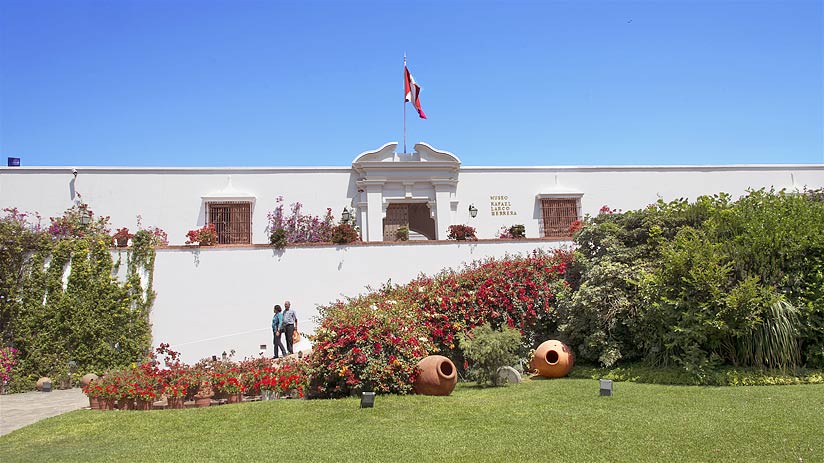Lima is the capital of Peru, and it is a city that in the last 10 years has seen incredible development. Even the city recently won the award for the best gastronomic destination at the World Travel Awards. But good food is not all that Lima has to offer. As a capital of a country that hosted the majority of ancient South American cultures, today Lima has an extraordinary museum with the largest ceramic, fabrics, and instruments collection belonging to the different prehispanic Peruvian cultures called Larco museum.
Travel Advisor Choice recognized it as the best museum in Latin America for two consecutive years. Therefore, if you have some free days and are looking for day trips from Lima, the Larco museum visit should be an inevitable item on your list. For this reason, together with the travel experts of Machu Travel Peru, we have proposed an article with everything you need to know about this awesome museum.
Everything you need to know about the Larco Museum in Lima
- What is the Larco museum?
- History
- Larco location
- Museum rooms
- Erotic art collection
- Larco cafe and boutique
- Prices and schedules of attention
- Other museum services
What is the Larco museum?
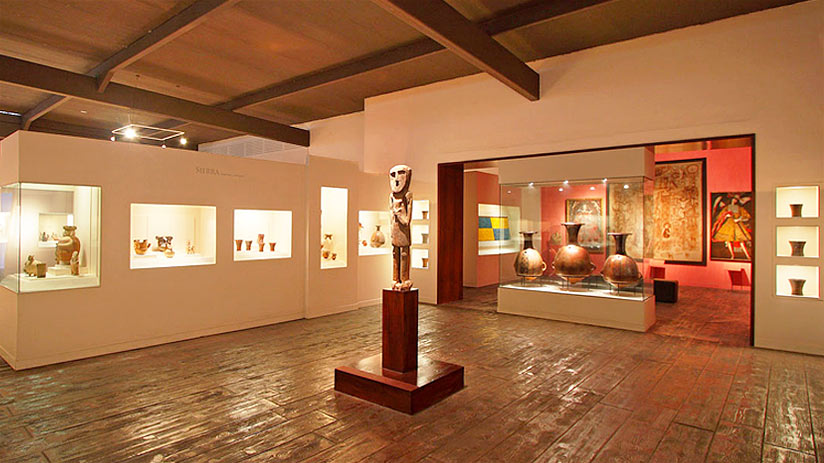
The museum mapping over 3,000 years of Peruvian history, and the collection features ceramics from the four most important cultural regions of Peru, these are the north coast, the center, the south, and the highlands. Larco’s collection includes more than 50,000 ceramics from the Cupisnique, Chimú, Chancay, Moche, Nazca, and Inca cultures, all presented in large, well-lit display cases.
But the museum not only houses ceramics but also a fine collection of fabrics, gold, and precious metals from the different cultures of Peru. Without mentioning that, Larco presents an awesome collection of fabrics from the Wari culture, some of which hold the record 398 threads per linear inch. Today, it’s considered a great achievement for an ancient culture! Even, many of the works still feature the wonderful colors used by this ancient culture.
An additional note, this museum is one of the few in the world that offers the possibility of visiting the storage room. You will be able to admire more than 35,000 ceramic artifacts from different ancient cultures. Considering that only about 5% of a museum’s collection is on display, this is a great opportunity!
History
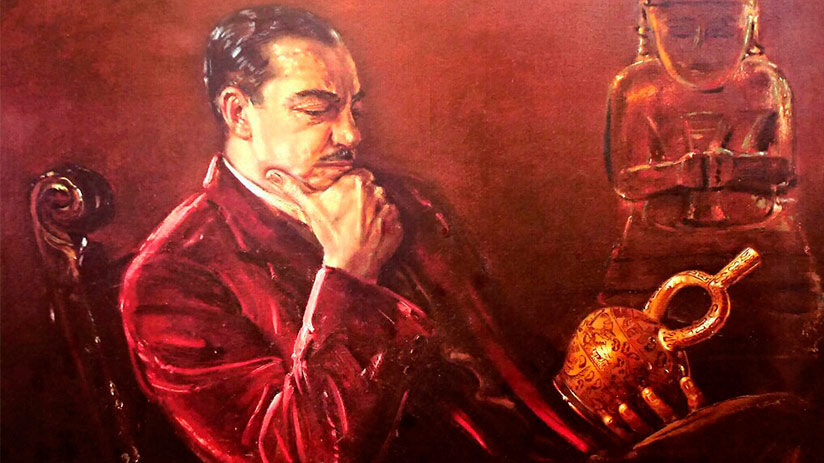
Rafael Larco Hoyle founded the museum in 1926 in honor of his father Rafael Larco Herrera, an important Peruvian politician, businessman, philanthropist, and collector. In 1923 Larco Hoyle received from his father a Huaco portrait called Head of Lord Priest (the Huacos were ceramics of heads of Moche deities), this was the unique ceramic that the Larco family conserved after the donation of all its ceramic collection of different prehispanic cultures to El Prado Spanish museum.
This piece of ceramic was the seed that gave rise to Larco Hoyle’s passion for archeology and love for his country’s past (Until then, he was a landowner, with studies in agriculture and administration in the United States, who managed his family’s farms in northern Peru) In this sense, years later of the museum foundation, he carried out archaeological excavations and continued acquiring and collecting ancient ceramic pieces of Peruvian prehispanic cultures, like a collection of more than 3000 ceramic pieces of a north Peruvian landowner named Carranza, and other collection of 8000 ceramics, fabrics and metal pieces from another landowner named Carlos A. Roa.
In this form, the museum was grown, and its old plant situated in the same Larco Hoyle’s ranch came up short. In 1953 Larco Hoyle moved the museum to its current location. In an 18th-century Spanish colonial mansion. This, in turn, was built over the ruins of an ancient 7th-century pyramid, making the Larco museum one of the most valuable historical buildings in Lima, nowadays.
Larco location
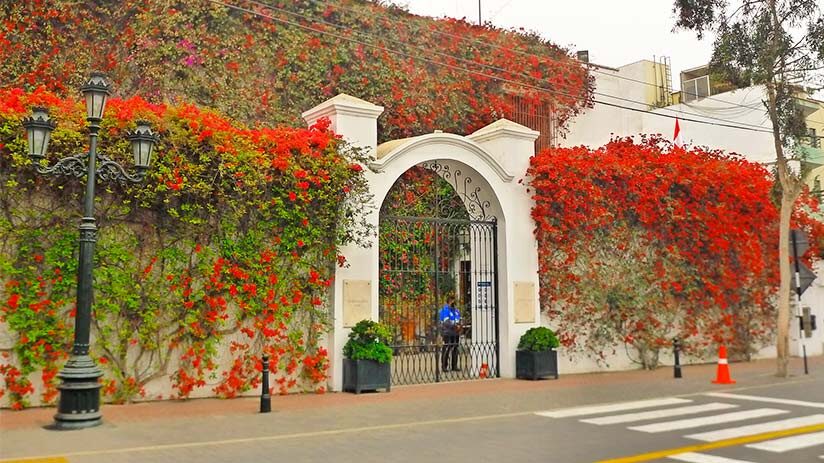
The address is Simon Bolivar, 1515 Avenue, Pueblo Libre district, Lima, Peru. Main entrance by Navarra Street. If you pay attention to a Lima travel guide, you will realize that the distance from the museum to the historic center of Lima is 6.3 kilometers (3.91 miles) and to Miraflores, the district where is located the majority of hotels, is 9 kilometers (6 miles)
As we mentioned, the Larco museum is located in a beautiful and ancient Spanish mansion from the 18th century, which was built over the rest of a millennial 7th-century pyramid. And to get there, you can take a taxi (We highly recommend using taxi apps like Cabify or InDriver, never take a taxi directly from the streets), the taxi cost will be around $8 to $12 from Miraflores and $5 to $10 from the Plaza de Armas of Lima (city historic center)
On the other hand, if you want to make your trip cheaper, you can take public transportation, a bus named “IO-89” from Kennedy park in Miraflores, the trip lasts 1 hour (but, first, you will have to indicate to the driver to make a stop in Larco museum to get off), the bus trip cost around $2. But, in the same way, we highly recommend using taxi apps to move there.
Museum rooms
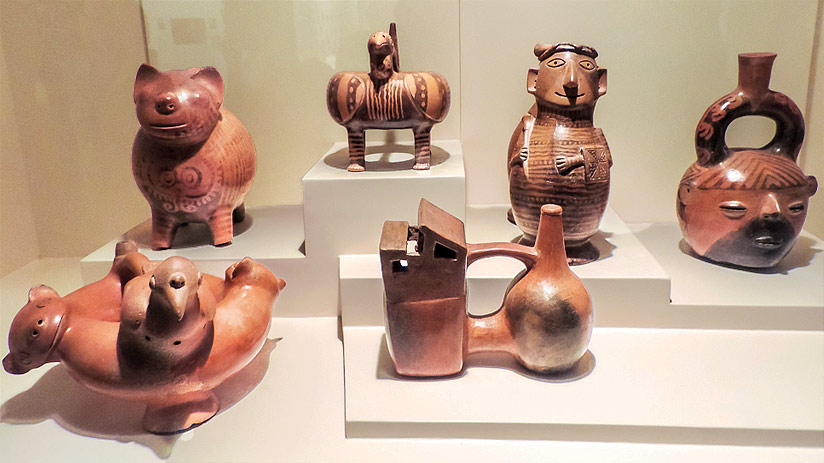
The museum in its mission to make the development of ancient Peruvian cultures more understandable is divided into different exhibition areas. Through them all, you will be able to observe in chronological order how these ancient prehispanic cultures were evolving until their splendor and fall. Among the exhibition areas, you can find:
- Introduction Room: Upon entering the museum, you will come across this small room which tells the story of Rafael Larco Hoyle. It briefly introduces the biography of the museum’s founder, such as his collection and the history of the Museo Larco. Also, there is a timeline that helps visitors understand the development of the Andean civilization and prepare them for the following rooms’ exhibitions.
- Gallery of Ancient Cultures: This trip covers Peruvian history from 5000 BC to the Inca period before the Spanish conquest. The gallery consists of four main rooms (2,3,4 and 5) that feature ceramic objects, stone works, and woodworks used by various cultures of ancient Peru. All exhibits are arranged by region and ordered chronologically, covering more than 6000 years of pre-Columbian history.
- Textile Room: Inside the Textile Room (Nº 6), you can see amazing examples of the technological and artistic mastery of ancient weavers, especially those belonging to Paracas culture. Alpaca and vicuña wool was used to weave garments of high quality since the earliest phases of civilizations in the Andes. These fabrics were used for articles of daily use, in ceremonies and offerings, and in burials, among other activities. Even with the advancement of technologies and skills, the parts became even more and more sophisticated! A note apart, next to this room, you will find fabric works by famous contemporary artists inspired by the looms of ancient Peru.
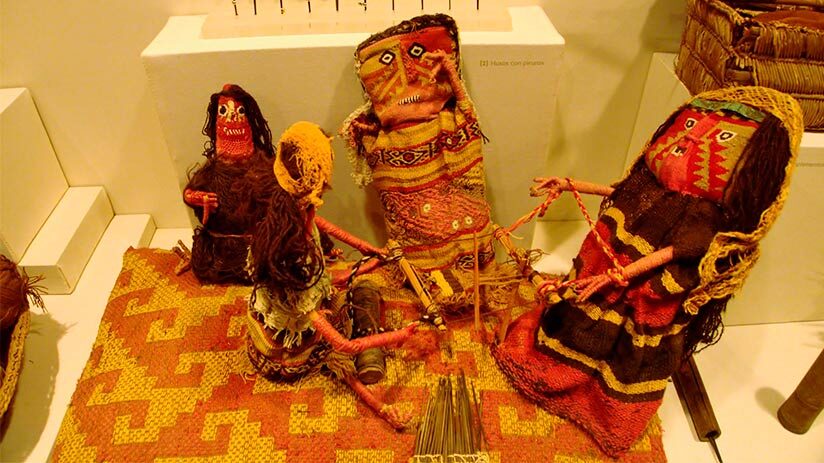
- Sacrificial Ceremony Room: This area of the museum (room Nº 7) introduces visitors to the ancient practices relating to human sacrifices in ancient Peru. These Human Offerings were very common among ancient cultures, in particular those belonging to Mochica culture. Often, these religious practices were considered sacred acts to thank or pay tribute to the gods. And you’ll see the graphic representation of these bloody rituals in ceramics and keros (ceremonial cups)
- Ceremonial Vessels Room: Inside this room (Nº 8), you will find a large selection of ceremonial vessels, which contain fermented drinks like the famous Chicha, sacred water, and blood of the sacrificed among other liquids used in rituals, ceremonies, offerings, and burials. The gallery shows cups, bowls, keros (ceremonial cups), and Aquillas (tall vases) made of wood, clay, and even precious metals like silver and gold. The objects made of gold and silver were used for rituals of the highest importance (related to the chief, king, or deity of the community). Don’t forget that ancient religious ceremonies were related to fertility, sacrifice, and the cult of the dead.
- Music instruments and war rituals room: In room Nº 9 you’ll find different objects, mostly gold and silver, used during diverse battles that had the Peruvian ancient cultures. Besides musical instruments that accompanied wars like Antaras (a kind of Andean wooden flute), Quenas (Small wooden flutes joined from the smallest to the largest), Whistles, and Drums among others.
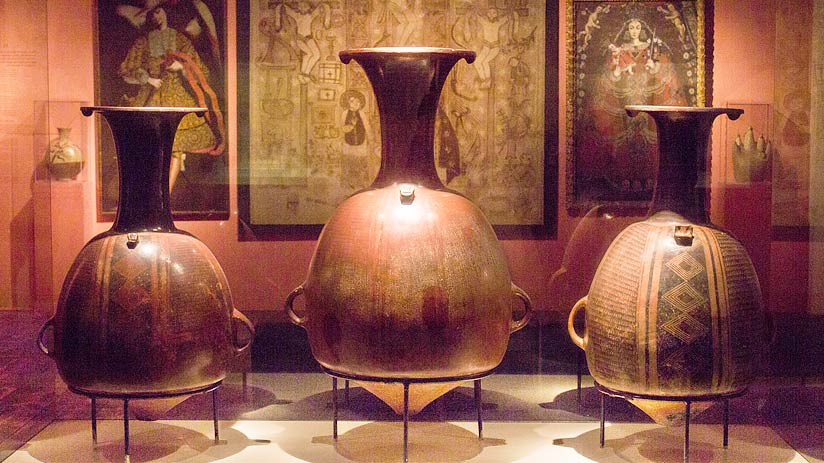
- Funeral instruments room: Room Nº 10 shows the different instruments (made of wood, silver, and gold) used in funeral and burial rituals in ancient Peru. One of the things in common that the different Peruvian cultures shared was that death did not mean the end, but the beginning of a new life. And the burial process was just a temporary step in which the instruments shown in this room were used.
- Gold and Jewelry Gallery: Inside rooms Nº 11, 12, and 13, you will find an exhibition of pre-Columbian pieces made of gold, silver, copper, and other various metals. You can find ceremonial pieces, funerary objects, and ornaments, between rings, bracelets, necklaces, bracelets, earrings, and even decorative jewelry from the clothing of kings, chiefs, and high priests of these ancient Peruvian civilizations.
- Storage room: The Larco museum is one of the few museums in the world that offers the possibility of visiting a storage room. You will have the possibility to admire more than 35,000 ceramic artifacts from different ancient cultures. Please note that they are all organized and labeled by topic and chronology. Considering that only about 4% of a museum’s collection is on display, this is a great opportunity to know best the legacy of these Peruvian cultures.
Erotic art collection
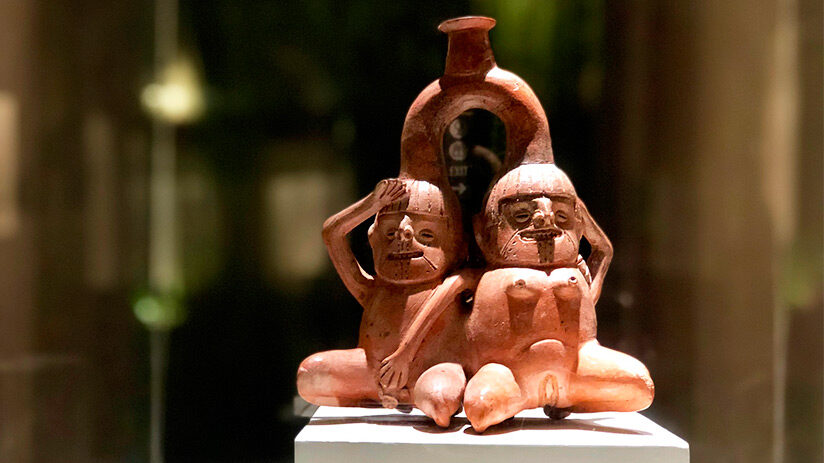
This collection of ceramic vessels portrays a variety of sexual positions and acts practiced by the ancient inhabitants of Peruvian cultures. This provides an approach to the perception of ancient Peruvian cultures to sexuality. Many of the erotic vessels were destroyed by the Spanish conquerors. Since they were mortified by the explicit sexual representation of the pottery, (Let us remember that the Europeans came to Peru in search of gold and silver treasures, under the pretext of evangelization and imposition of good customs to the native South Americans). But fortunately, many of these ceramics survived the passage of time and are on display today in this museum room.
- Motherhood and female body gallery: This room shows that the ancient Peruvian inhabitants were already aware that the most beautiful thing in this world was the body of a woman. In this gallery, you’ll find ancient ceramics and sculptures of a woman’s body, her genitals, and representations of pregnant bodies.
- Sexual act and fertility gallery: Maybe these ceramics would be the most explicit among all the collections. These ceramics represent the sexual act between a man and woman in different positions, some of them even resemble the Kamasutra.
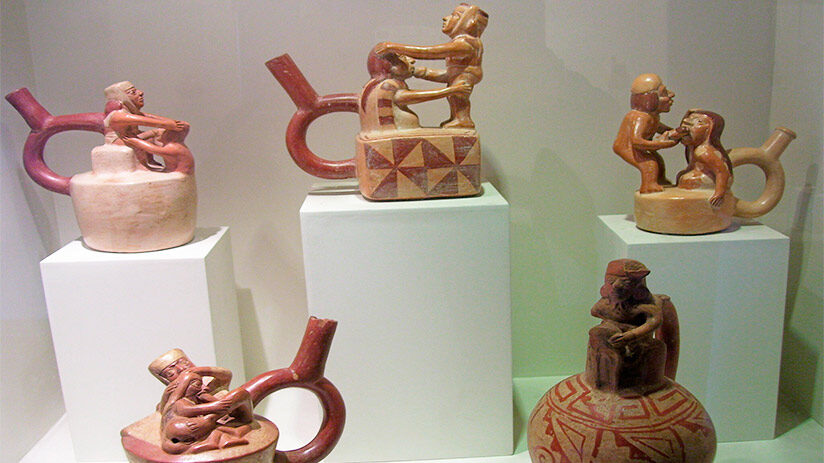
- Underworld gallery: For the Mochicas (the pre-Inca culture to which most erotic ceramics belong), death was a second life, and the inhabitants who belonged to it, were sex addicts, practicing sexual relations between them. Even with people of this life, the world of the living. Mostly scenes of sexual interaction with Mochica ancestors.
- Non-reproductive sexual act gallery: The ancient Peruvians were already aware that sex not only had a reproductive purpose, but also pleasure. Justly, this room shows sex acts like masturbation, anal sex, and even fellatio. Actually, some scholars affirm that these practices were performed in order to worship the dead, in addition to obtaining pleasure. One of the ceramics represents a woman carrying the predominant role during the sexual act, this ceramics is better known as “Tinkuy Sexual”.
- Male body and sexual incitement gallery: These ceramics shows the initiation of act sex having the man as an active part, and the woman as a passive part. The ceramic forms present kisses, caresses, and touching of the female body. Also, you’ll find crocks in the form of male genitals, female genitals, and fellatio scenes.
Larco cafe and boutique
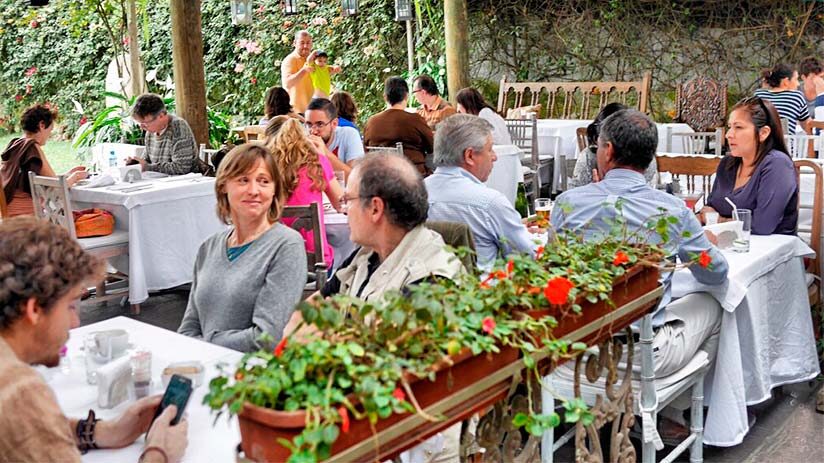
The museum has a Cafe Restaurant located on the second floor, on the terraces that overlook the beautiful gardens of the Spanish mansion. The restaurant presents a cozy and pleasant atmosphere where the visitor can enjoy of variety of food (cold and hot plates) like sandwiches, desserts, cakes, salads, and hot and cold beverages.
On the first floor, surrounding the gardens is located the Larco boutique store where the visitant will acquire remembers of the museum like jewelry, fabrics, and replicas of art pieces inspired by masterpieces of the Larco collection. Also, the creations of Peruvian artists related to the Larco collection theme are sold at the same prices as their ateliers.
Prices and schedules of attention
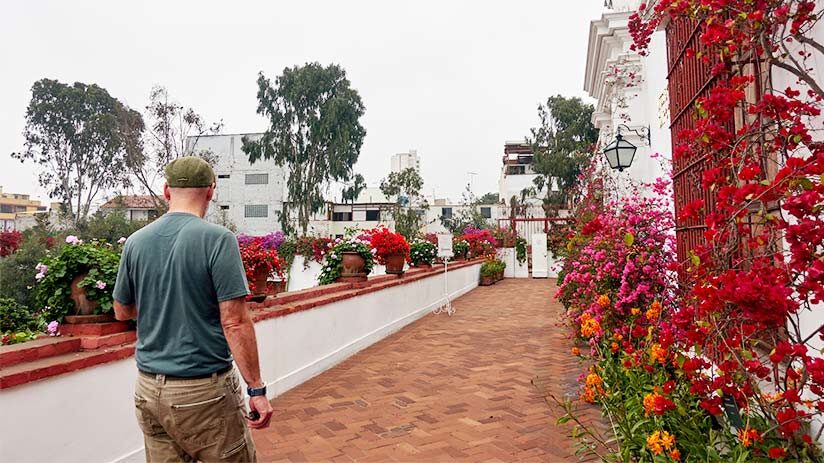
Undoubtedly, a visit to the Larco museum is one of the best things to do in Lima. The museum has extended hours of attention throughout all week.
- Monday – Sunday: From 10:00 am to 07:00 pm.
- Reduced hours: December 24, 25, and 31 and January 1st from 10:00 am to 06:00 pm.
The cost of the entrance depends on the age of the visitors.
- The general admission costs 35.00 Soles or $10.
- The ticket for older adults (More than 60 years old) costs 30.00 Soles or $8.
- Students and underage persons (From 9 to 17 years old): 17.00 Soles or $5.
- Children (Until 8 years old): Free entrance.
The entrance can be bought at the following link https://www.museolarco.org/tickets/
Other museum services
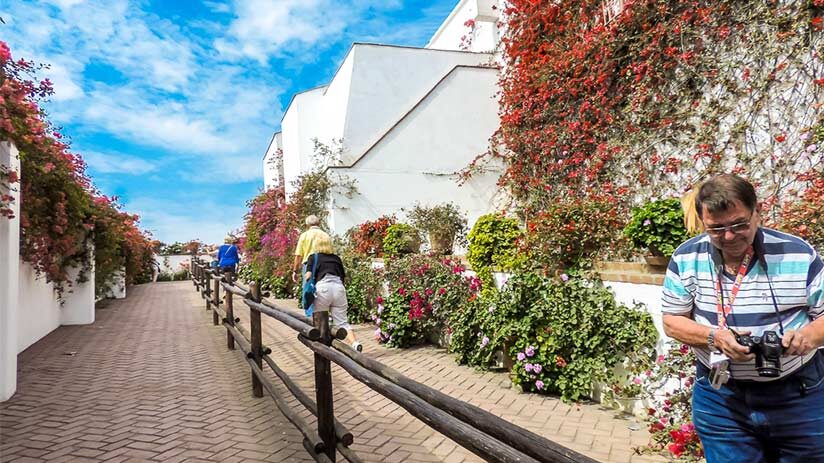
To be considered one of the best museums in South America and the Lima art museum par excellence is not only for the type of collection that it hosts but for the additional services that it provides.
- Accessibility: The rooms of exhibitions and sanitary facilities are connected by ramps. Guide dogs are welcome. Free wheelchair loan on the first level. Baby changing tables available in the restrooms on both floors.
- Sanitary facilities: Larco has two central sanitary facilities, one of them is located on the first floor, just one side of Larco Cafe Restaurant. The other is situated between exhibition rooms on the second floor. Both are implemented with access to handicapped people and baby changing tables.
- Languages: All room galleries have descriptions below every ceramic in Japanese, French, German, Italian, English, and Spanish.
- Wi-Fi: Free Wi-Fi in exhibition rooms, visitable warehouses, gardens, and museum café.
- Luggage storage: Visitors can deposit bags, backpacks, and suitcases in the reception area of the museum. But, previously, they have to consult the luggage and backpack policies of the museum to know what size of luggage is permitted.
- Parking zone: The museum hasn’t parking zone, but the cars of visitants can be parked on Navarra street and Simon Bolivar Avenue.
- Photography: Professional photography with flash is forbidden, as well as the use of tripods and selfie sticks, and selfie photos. For the other cases, (amateur photography without flash) is allowed in all the exhibition rooms.
“REAL MUSEUMS ARE PLACES WHERE TIME IS TRANSFORMED INTO SPACE”
As you may have read, a visit to the Larco Museum is a must on the different tours in Peru. If you plan to spend a few days in the Peruvian capital, be sure to reserve a day for the museum tour. Don’t mind the best time to visit Lima, the tour to the Larco museum is timeless and worth visiting at any time. This place is key to beginning to understand the historical transformations of the many cultures that lived in Peru. Together with the experts from Machu Travel Peru, we hope we have been helpful. If you want to know more about our tours of the city, be sure to consult with our qualified advisors.
